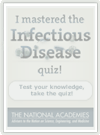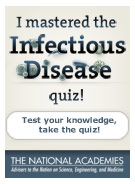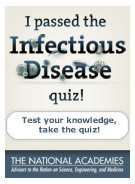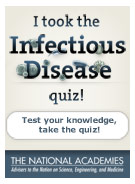
What You Need To Know About Infectious Disease
What do you know about infectious disease?
True or False: Thimerosal, a mercury-containing preservative that was used in some vaccines and other products, has been shown to present a risk to human health.
-
Sorry, that’s incorrect.
The use of thimerosal has been an object of controversy, with some arguing that the substance caused autism in children. However, extensive independent research has presented no convincing evidence of harm associated with the low levels of thimerosal previously present in vaccines.
-
Correct!
The use of thimerosal has been an object of controversy, with some arguing that the substance caused autism in children. However, extensive independent research has presented no convincing evidence of harm associated with the low levels of thimerosal previously present in vaccines.
The human papillomavirus (HPV) causes about what percentage of cervical cancer cases?
-
Sorry, that’s incorrect.
The human papillomavirus (HPV) causes more than 90% of cervical cancer cases.
-
Sorry, that’s incorrect.
The human papillomavirus (HPV) causes more than 90% of cervical cancer cases.
-
Correct!
The human papillomavirus (HPV) causes more than 90% of cervical cancer cases.
Which of the following is NOT a vector-borne disease?
-
Correct!
Influenza is not a vector-borne disease, meaning it is not transmitted to humans indirectly via an insect, an arthropod, or another animal. Malaria and yellow fever are transmitted by mosquitoes. Lyme disease is transmitted by deer ticks.
-
Sorry, that’s incorrect.
Influenza is not a vector-borne disease, meaning it is not transmitted to humans indirectly via an insect, an arthropod, or another animal. Malaria and yellow fever are transmitted by mosquitoes. Lyme disease is transmitted by deer ticks.
-
Sorry, that’s incorrect.
Influenza is not a vector-borne disease, meaning it is not transmitted to humans indirectly via an insect, an arthropod, or another animal. Malaria and yellow fever are transmitted by mosquitoes. Lyme disease is transmitted by deer ticks.
-
Sorry, that’s incorrect.
Influenza is not a vector-borne disease, meaning it is not transmitted to humans indirectly via an insect, an arthropod, or another animal. Malaria and yellow fever are transmitted by mosquitoes. Lyme disease is transmitted by deer ticks.
Which of the following can be treated with antibiotics?
-
Sorry, that’s incorrect.
Strep throat is a bacterial infection that can be treated with antibiotics. The common cold and influenza are both viral infections, which do not respond to antibiotics. Antivirals may be prescribed instead.
-
Correct!
Strep throat is a bacterial infection that can be treated with antibiotics. The common cold and influenza are both viral infections, which do not respond to antibiotics. Antivirals may be prescribed instead.
-
Sorry, that’s incorrect.
Strep throat is a bacterial infection that can be treated with antibiotics. The common cold and influenza are both viral infections, which do not respond to antibiotics. Antivirals may be prescribed instead.
-
Sorry, that’s incorrect.
Strep throat is a bacterial infection that can be treated with antibiotics. The common cold and influenza are both viral infections, which do not respond to antibiotics. Antivirals may be prescribed instead.
Since the beginning of the 20th century, the number of people in the world has:
-
Sorry, that’s incorrect.
Since the beginning of the 20th century the number of people in the world has more than quadrupled—from 1.6 billion to nearly 7 billion—and world population is expected to rise to well over 9 billion by 2050.
-
Sorry, that’s incorrect.
Since the beginning of the 20th century the number of people in the world has more than quadrupled—from 1.6 billion to nearly 7 billion—and world population is expected to rise to well over 9 billion by 2050.
-
Correct!
Since the beginning of the 20th century the number of people in the world has more than quadrupled—from 1.6 billion to nearly 7 billion—and world population is expected to rise to well over 9 billion by 2050.
In 2008, about how many people worldwide were infected with HIV (human immunodeficiency virus)?
-
Sorry, that’s incorrect.
In 2008, more than 33 million people worldwide were infected with HIV (human immunodeficiency virus). In that same year, an estimated 2 million people died from AIDS (acquired immunodeficiency syndrome), the final stage of HIV infection.
-
Sorry, that’s incorrect.
In 2008, more than 33 million people worldwide were infected with HIV (human immunodeficiency virus). In that same year, an estimated 2 million people died from AIDS (acquired immunodeficiency syndrome), the final stage of HIV infection.
-
Correct!
In 2008, more than 33 million people worldwide were infected with HIV (human immunodeficiency virus). In that same year, an estimated 2 million people died from AIDS (acquired immunodeficiency syndrome), the final stage of HIV infection.
Which of the following is an effective way to protect yourself against infectious disease?
- Keep immunizations up to date
- Wash your hands often
- Prepare and handle food carefully
- All of the above
-
Sorry, that’s incorrect.
All of the above can help prevent infectious disease. Other behaviors, such as exercising caution around wild and unfamiliar domestic animals, avoiding insect bites, practicing safe sex, and being vigilant about disease threats while traveling abroad, can also reduce the risk of infection.
-
Sorry, that’s incorrect.
All of the above can help prevent infectious disease. Other behaviors, such as exercising caution around wild and unfamiliar domestic animals, avoiding insect bites, practicing safe sex, and being vigilant about disease threats while traveling abroad, can also reduce the risk of infection.
-
Sorry, that’s incorrect.
All of the above can help prevent infectious disease. Other behaviors, such as exercising caution around wild and unfamiliar domestic animals, avoiding insect bites, practicing safe sex, and being vigilant about disease threats while traveling abroad, can also reduce the risk of infection.
-
Correct!
All of the above can help prevent infectious disease. Other behaviors, such as exercising caution around wild and unfamiliar domestic animals, avoiding insect bites, practicing safe sex, and being vigilant about disease threats while traveling abroad, can also reduce the risk of infection.
How many people in the world do not have access to an adequate water supply?
-
Sorry, that’s incorrect.
Worldwide, 884 million people do not have access to an adequate water supply, and about three times that number lack basic sanitation services. An estimated 2 million deaths a year can be attributed to unsafe water supplies.
-
Sorry, that’s incorrect.
Worldwide, 884 million people do not have access to an adequate water supply, and about three times that number lack basic sanitation services. An estimated 2 million deaths a year can be attributed to unsafe water supplies.
-
Correct!
Worldwide, 884 million people do not have access to an adequate water supply, and about three times that number lack basic sanitation services. An estimated 2 million deaths a year can be attributed to unsafe water supplies.
About how many airline passengers cross international borders daily?
-
Sorry, that’s incorrect.
An estimated 1.8 million airline passengers cross international borders daily, creating routes by which human infections can radiate around the world within hours.
-
Sorry, that’s incorrect.
An estimated 1.8 million airline passengers cross international borders daily, creating routes by which human infections can radiate around the world within hours.
-
Correct!
An estimated 1.8 million airline passengers cross international borders daily, creating routes by which human infections can radiate around the world within hours.
Thank you for taking our quiz.
Place this badge on your Facebook page to show your friends what you know about infectious disease.
Place this badge on your Facebook page to show your friends what you know about infectious disease.
OR, get a higher score to unlock a different badge.

Place this badge on your Facebook page to show your friends what you know about infectious disease.
OR, get a higher score to unlock a different badge.

Explore Other Topics
Disease Watchlist
Infectious Disease Defined
- Antibiotic Resistance
The process through which pathogenic microorganisms, by way of genetic mutation, develop the ability to withstand exposure to the drugs that had once been successful in eradicating them.


